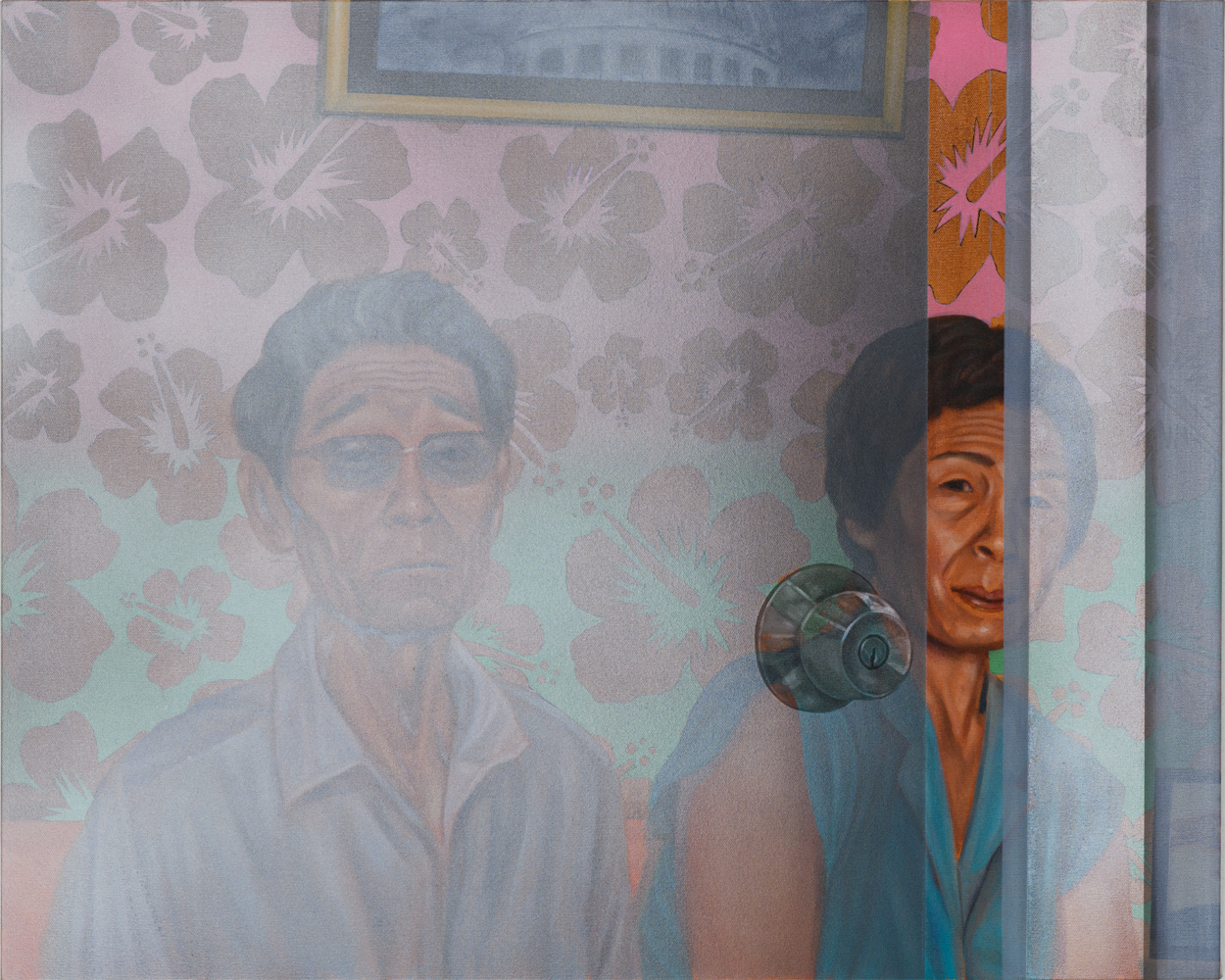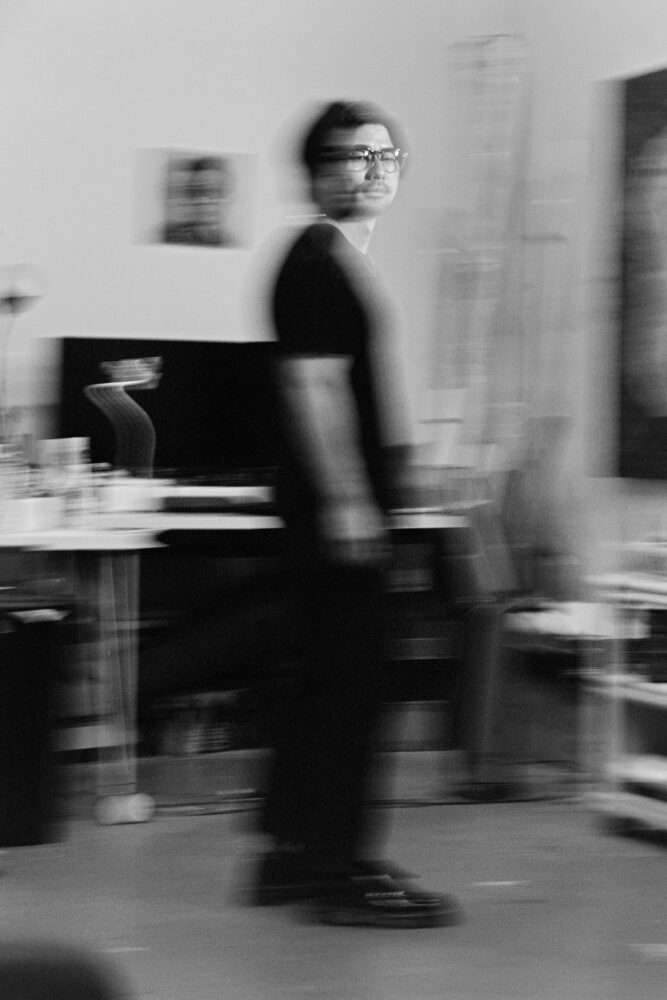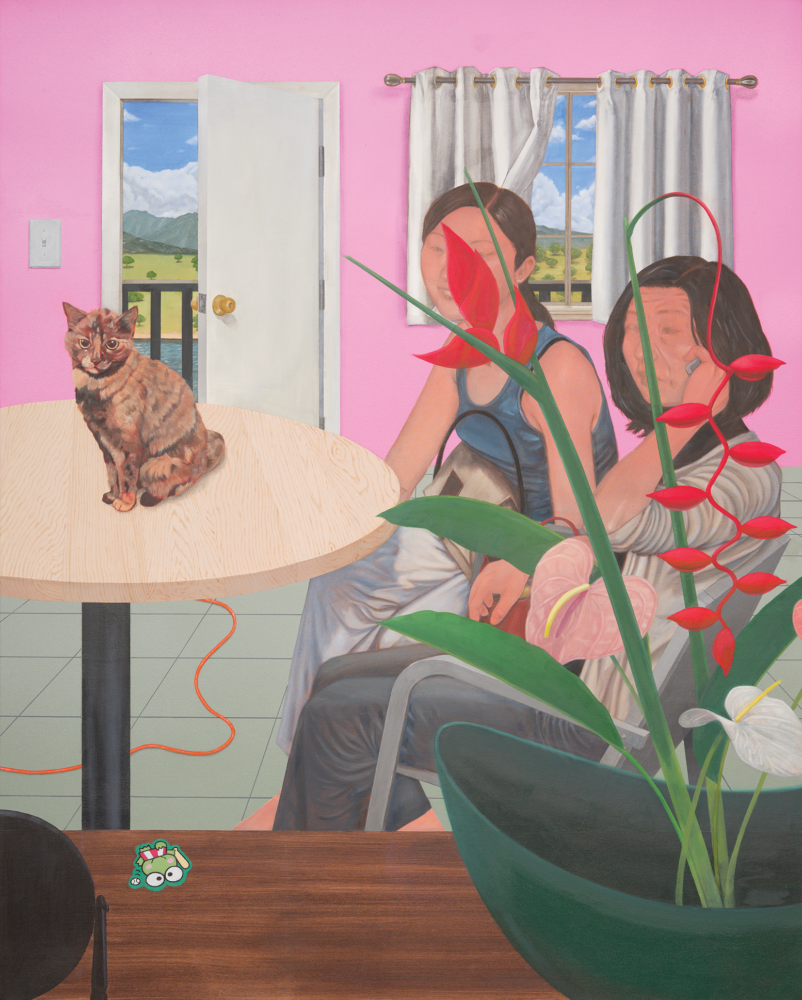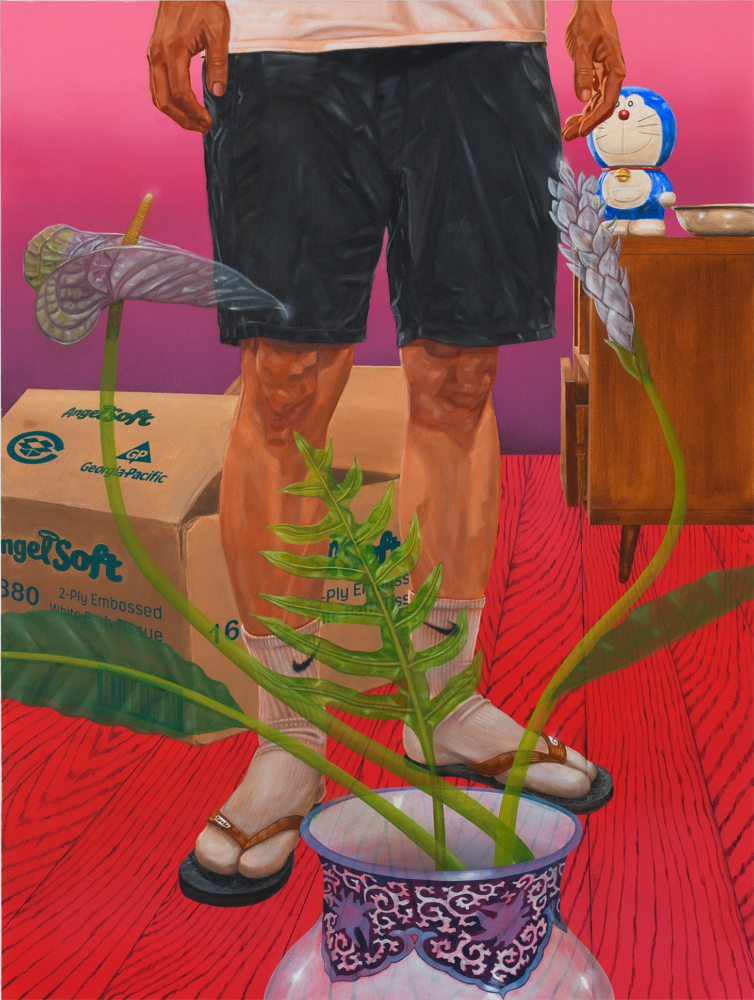The L.A.-based Shingo Yamazaki paints a multicultural Hawai‘i upbringing steeped in meditations on identity and memory.
Images by Sam Muller
A couple sits down to dinner. On the table there’s a Budweiser for him (bottled, not canned), a water for her (tap, not bottled), and a plate and two bowls between them. The booth behind them is cherry red and the walls are covered in wallpaper patterned with anthuriums.
The painting, Remember to Forget, by Honolulu-born artist Shingo Yamazaki captures an intimate moment, only there’s a scrim separating we, the onlookers, and the two eaters in the frame. Translucent yet opaque brush strokes cover the entire canvas, obscuring certain details, which makes the act of gazing feel like spying on someone through a dirty window pane.
“I call them interjections,” says Yamazaki, whose portraits explore the nuances of identity, multiculturalism, home, and belonging. The technique is actually called “glazing,” where transparent oil paints are painstakingly layered to create a full image, and they’re a consistent presence in Yamazaki’s work for their ability “to simultaneously allow and deny access.”
In Transient Veil, a straightforward portrait of a man — the same one at the dinner table: aged, handsome, wearing wire-rimmed glasses — is interrupted by what appears to be a hanging aloha shirt, unbuttoned and forest green with pink and yellow plumeria. It partially obscures his face from his forehead to nose.


“I was really thinking about how we self identify, or personhood, and how those interactions create relation to reality and psychological space,” Yamazaki explains of his fondness for glazing. His late grandmother lived with dementia and the method worked as a metaphor for memory and the self. By precisely controlling the distance between his viewers and his subjects, often his family members or friends and inspired by old photographs, Yamazaki can spotlight or shroud each figure, creating presence or absence, and “instill a sense of in-betweenness at the same time.”
This “in-betweenness” could be spatial too. In In Transit, a young boy sits with his mother in a minivan as a gate rises, about to enter a parking garage; in Beyond the Pacific, his grandparents are seen behind a pellucid door that’s ajar. These interstitial themes extend to cultural representations as well. As a Japanese Korean born and raised in Hawai‘i, Yamazaki is acutely aware of both the hybridity and intersectionality of his own body and the islands’ melting pot society, which is why in his art, “I try to embed different iconographies and cues from my upbringing,” he says.


Across his oeuvre, there are recurring motifs. Hawai‘i’s flora — spindly anthuriums, scaly ginger, elongated bird of paradise — are often composed in ikebana arrangements as a nod to his family who practices the artform. Local clothing from vivid aloha shirts to slouchy T&C tees adorn the subjects. Island foods like portable Spam musubi and glistening chirashi bowls also appear.
“When I paint, I can embed different things within the work in a really subtle way where they’re coexisting,” says Yamazaki. Remnants of Nostalgia shows a figure from the thighs down, wearing purple shorts and Nike socks tucked into Locals rubber slippers, intimating a crossover between Hawai‘i, Japanese, and American style.
The idea of coexistence became central to Yamazaki’s paintings after moving from O‘ahu to Los Angeles in 2018. Despite the large Asian population in California, he found the communities were often isolated. Asian restaurants were clustered in Koreatown or Japantown or Chinatown. Items he’d find in any local Hawai‘i supermarket — sushi rice, fish sauce, kimchi — he’d have to purchase from an Asian-specific grocery store instead.


The differences in language (“soy sauce” instead of “shoyu”), driving (aggressive honking instead of throwing shakas), and mindset (individualism over community) became a clear contrast to Hawai‘i, prompting Yamazaki to think more deeply about how cultures come to exist and their histories. “It’s such a rich mixture, that you don’t even realize what it is,” he says of Hawai‘i. “If you’re eating a plate lunch,” a dish that originated on the plantations where Chinese, Japanese, Filipino, and Portuguese immigrants labored, “you’re not pointing out the origins of each item.”
Distance from home and the ability to paint during the pandemic (his day job as a flight attendant for Hawaiian Airlines was paused during lockdown) gave Yamazaki the space to create a coexistence of identities, cultures, and personhood on the canvas. The work “speaks to a broader conversation on identity and being very specific and accurate about trying to depict those complexities,” he says, “because historically certain kinds of identities were not typically addressed.”
When I paint, I can embed different things within the work in a really subtle way where they’re coexisting.
Shingo Yamazaki
Yamazaki speaks from personal history here. His mother, who is half Korean, partially grew up in Hiroshima, Japan. His maternal Korean grandfather, who had lived there for decades, experienced the atomic bombing in 1945. Japan was — and to some extent still remains — notoriously hostile to Koreans. As a result, Yamazaki, 38, didn’t learn he was also Korean until he was 17 years old.
“My mom doesn’t generally like talking about being Korean having grown up in Japan,” he explains. Yet the news wasn’t a total shock. “I already had a feeling because my grandma had all this Korean paraphernalia around the house.” Yamazaki understands that the immigrant’s refusal to talk about generational trauma doesn’t necessarily replace the underlying, unspoken knowledge their offspring possess.


Painting for him then is, as he puts it, an “uncovering process.” Interjections, with their ability to conceal and reveal simultaneously, mirror the process Yamazaki continually finds himself undergoing with respect to his own identity, heritage, and family history. In preparation for several upcoming group shows and one solo show, he’s been “working with the idea of filling in the blanks as a way of trying to reconnect with this lack of generational knowledge.”
Lately, Yamazaki has been contemplating the history of objects and traditions, how certain ones have been adopted or changed from movement and migration. In his Boyle Heights studio now, there are hanafuda cards, the Japanese playing card game, and Pogs, the stack and slam game popularized on Maui by the passion fruit, orange, and guava juice manufacturer. Both are “originally from Japan but popularized in Hawai‘i and then the mainland, so they’ve gone through this whole traveling and migration process,” he says. “That’s really applicable to how we self identify and shift, the way we live our lives and continue our paths.”
Yamazaki’s desire to fill in the blanks is personal but also universal. All the major characters in his work, which include his grandparents and family, classify as what the novelist Min Jin Lee has called “minor characters in history”: the everyday, ordinary people who are frequently underappreciated and overlooked, their stories left unrecorded.
“We cannot help but be interested in the stories of people that history pushes aside so thoughtlessly,” the author has said, which can explain the appeal of Yamazaki’s art. As viewers, we cannot help but admire the artist who places his family’s own, unknown histories front and center, deserving of the light to be seen.

